AMD is launching its socket AM1/ FS1b based Kabini SoC’s. We already benchmarked and reviewed the Athlon 5350 “high-end” model as well as the Athlon 5150 mid range option. For those wondering, tomorrow we will have benchmarks of the fourth and final AM1 processor, the Sempron 3850. The AMD Sempron 2650 we are reviewing today is the second lowest performance model of the four model socket AM1 lineup. The AMD Sempron 2650 is a 25w TDP AM1 processor with only two Jaguar generation cores at 1.45GHz. L2 cache is likewise cut from 2MB on the quad core parts to 1MB on the Sempron 2650. One still gets lower clocked Graphics Core Next (GCN) cores however with low processor performance and single channel memory bandwidth, we are not expecting much. We are not going to test the GPU today since we typically focus on CPU benchmarks with our Linux test suite. Just to make things fun, we have the Sempron 3850 results added as well as a few cloud benchmarks added into the results.
Test Configuration
We were a bit limited by the fact that we purchased the components at retail prior to the official launch. AMD and ASUS did not provide these components prior to launch.
- CPU: AMD Sempron 2650 (with retail heatsink/ fan)
- Motherboard: ASUS AM1I-A
- Memory: 8GB (2x4GB) DDR3 1600MHz
- SSD: Samsung 840 Pro 256GB
- OS: Ubuntu 13.10 server
- Power supply: PicoPSU 150XT
Although we are testing with 8GB of RAM 4GB is a more likely configuration. Realistically this platform will be used in highly budget constrained environments or environments were little memory is needed such as network appliances and NAS systems (albeit RAM does help cache reads for NAS units.)
AMD Sempron 2650 Benchmarks
We are using our standard Linux benchmarking suite to get an idea about the AMD Sempron 2650 dual core processor performance. As a direct result of user feedback, we recently had the benchmarks all put into a single script that you can use to benchmark your own systems. As development has progressed on the next version we have moved the current script to STHbench 2013 – Download and Instructions as a resource on the forums. That guide has three simple commands that you can use with a stock installation to run our test suite and install/ compile all necessary files. No configuration is needed. For the next generation development version which currently can also run on CentOS and Mint, and expands the suite to include sysbench and redis-benchmark results, look here: (see Introducing the STHbench.sh Server Benchmarking Script).
The net goal is that we want others to be able to reproduce benchmarks and compare directly to their systems. Since we do not have access to every possible configuration, we would appreciate feedback in that thread which can be as simple as posting log files to run. Help is always appreciated!
Hardinfo Performance
hardinfo is a well known Linux benchmark that has been around for years. It tests a number of CPU performance aspects. One major advantage is that one can run this out of the box from many Ubuntu installations.
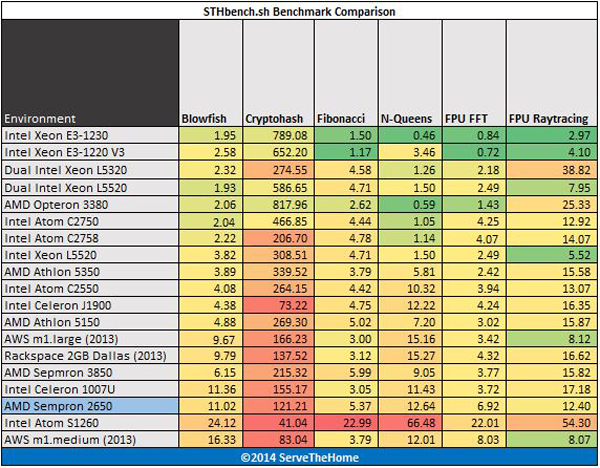
The AMD Sempron 2650 sits somewhere in the stack faster than an older design Intel Atom SoC (e.g. the S1600 family and the D525 for example) but significantly slower than even processors that cost a few dollars more. This is a theme we will see repeated.
UnixBench 5.1.3 Performance
UnixBench may be a defacto standard for Linux benchmarking these days. There are two main versions, one that tests single CPU performance on that tests multiple CPU performance. UnixBench segments these results. We run both sets of CPU tests. Here are the single threaded results:
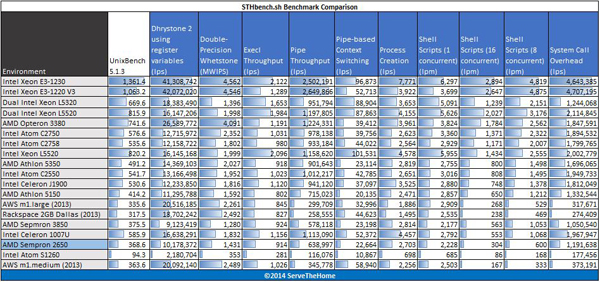
Our single threaded CPU test portion of UnixBench 5.1.3 shows some performance aspects similar to other lower end processors, however the dual core Intel Celeron 1007U and 1037U low power processors are going to be a bit faster.
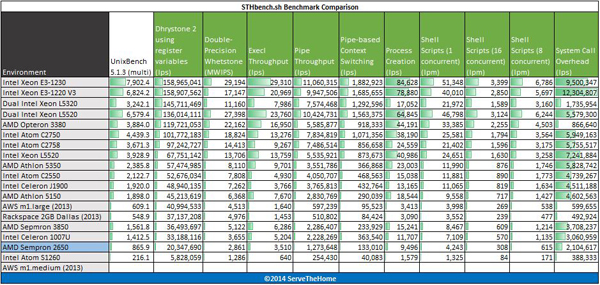
On the multi-threaded benchmarks dual 1.45GHz cores makes it one of the lower performing results we have. It is however faster than cloud instances such as the legacy AWS m1.large and Rackspace 2GB Dallas instances in our UnixBench tests.
c-ray 1.1 Performance
c-ray is a very interesting ray tracing benchmark. It provides both consistent results and some clear separation. Ray tracing is generally a great multi-threaded CPU benchmark. For this test we use both a simple 7500×3500 render and a more complex 1920×1200 render. Here are the results: Our c-ray benchmark shows some fairly solid performance using c-ray’s rendering benchmark.
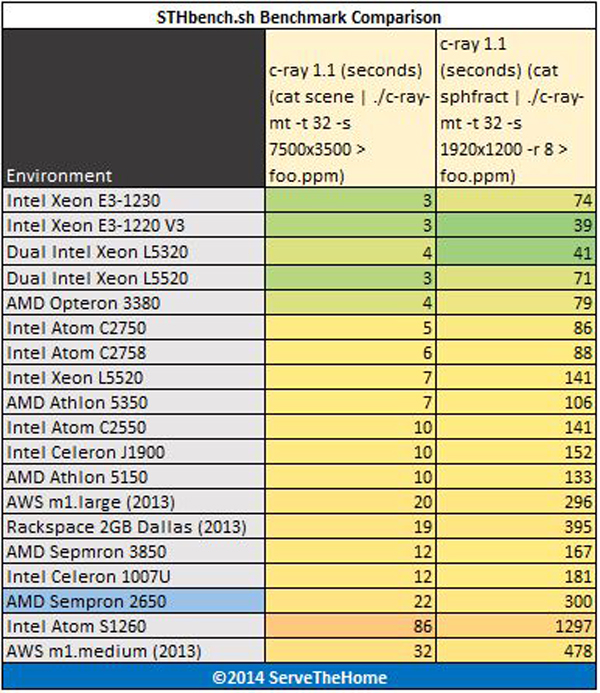
Although we have seen generally decent performance from the new Kabini APUs previously, the Sempron 2650 c-ray benchmarks paint a picture of a chip struggling with higher end workloads. On one hand this is what we would expect. On the other hand, the Sempron 2650 is not 1/2 the price of a Sempron 3850.
Phoronix Test Suite Performance
We are using four tests from the Phoronix Test Suite: pts/stream, pts/compress-7zip, pts/openssl and pts/pybench.
- STREAM by John D. McCalpin, Ph.D. is a very well known memory benchmark benchmark.
- 7-zip compression benchmarks were a mainstay in our Windows suite so we are including it again on the Linux side as a compression benchmark.
- The pts/openssl benchmark is very dependent on the CPU architecture being used
- Python is a widely used scripting language and pyBench is a nice single-threaded Python benchmark
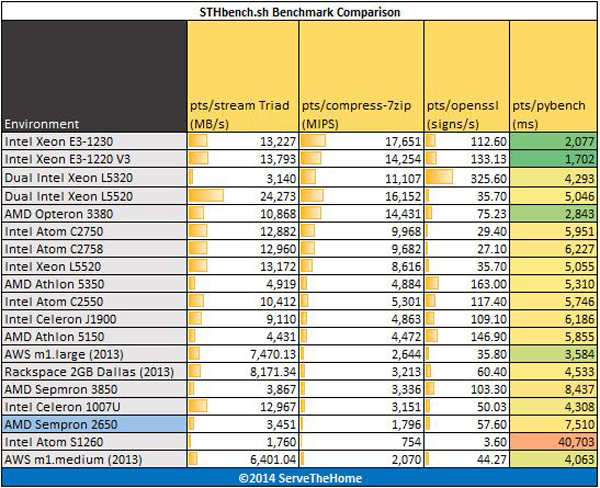
Again we see the impact of single channel memory bandwidth on STREAM benchmark results. One other interesting note here is that the STREAM figures continue to decrease as we go down the AM1 lineup. At this point, the Sempron 2650 is distancing itself from older generation Atom architectures, but it is clearly showing its limitations.
Crafty Chess Performance
Crafty is a well known chess benchmark. It is also one where we saw issues last time with the Phoronix Test Suite and running on ARM CPUs. We are planning to retire this benchmark in the 2014 version of STHbench. Here are the Crafty Chess results from simply running “crafty bench”:
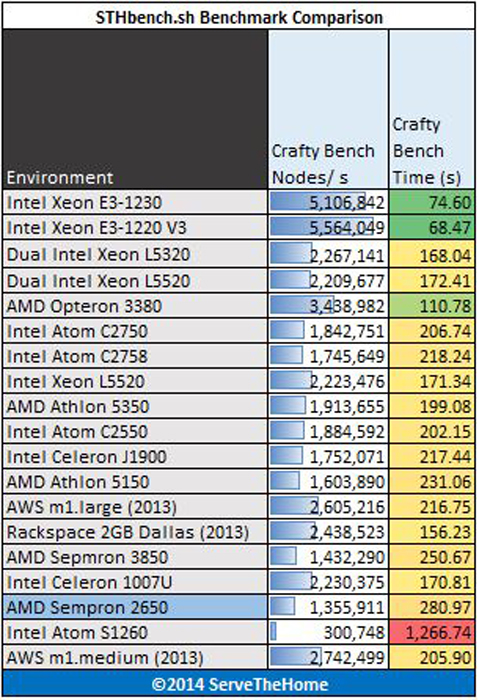
Crafty results show the impact of 1.45GHz clock speeds since they are single threaded results. We would have expected better results than the 1.3GHz Sempron 3850 due to clock speed, however it is quite possible that there is an impact of lower memory throughput we saw with STREAM that is negatively impacting performance here.
A word on power consumption
Our sample measured a few thenths of a watt lower in idle and load power consumption versus the Athlon 5350 and 5150. We are planning to have a full comparison of all AM1 chips and add in Bay Trail-D.
- Idle power consumption: 15.0w
- Maximum power consumption during benchmarks: 18.8w
We did do thermal imaging on our AMD Athlon 5350 review which gives one a good idea regarding how cool these systems run.
Conclusion
Overall the AMD Sempron 2650 is inexpensive. I think the bigger question is whether it is worth saving a few dollars versus getting a slightly higher performing solution. In markets where $25 is a big deal, the Sempron 2650 at least provides some level of performance and x86 compatibility. Also, if one is looking for an ultra low cost pfsense or FreeNAS style box using low quality NICs and higher power consumption than Bay Trail-D, then this may be an appealing platform. We will be testing this style of appliance in the near future but this is probably not the ideal processor for a Windows desktop unless one has severe budget constraints. Here is an interesting perspective though, pfsense and Linux based NAS servers with other functions (e.g. Synology, Thecus, QNAP and others) all have worked perfectly well with the older generation Atom D510, D525 and N2700′s that are more similar in performance to the Intel Atom S1260. There is still a market for low power, low performance compute in these types of environments.

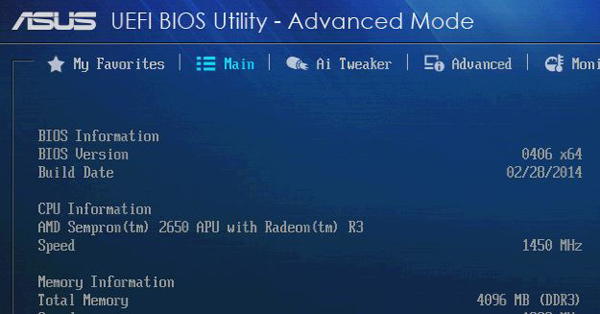



What about linux mint 17 with xfce? And plus with monitor 1600 x 800. Plus amd hd Radeon 6450 2 GB, please let me know.